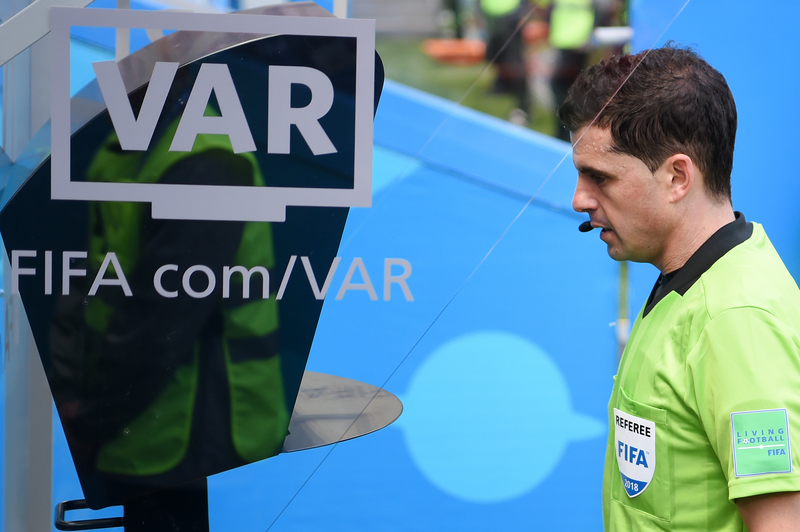When an offside goal was awarded to Brentford in the game against Arsenal, we all knew AFTV was going to have a field day during their post-match rants.
But this one was different, not like Brighton getting robbed multiple times during a game, not like Bruno’s controversial offside goal. This particular error had implications for the 2022/2023 EPL title.
And when Howard Webb came the next day to apologize for Lee Mason’s error in spotting the offside player, the entire English football mediascape went into a frenzy. Arsenal fans fumed and called for the VAR’s head.
Just like that, we came back to the age-old question: how can we fix VAR?
If you have the same question or don’t even know what VAR is, we’ve got you covered. Let’s discuss ways to fix VAR before it ruins the game we love.
What is VAR?
VAR (video assistant referee) is a group of three to four video professional officials who assess incidents that occur during games, stationed in a central video operation room.
The VAR interferes when the on-field referee misses a key incident or needs to review it from multiple viewpoints. Here are four incidents that the VAR system can review:
- Goals: to determine whether a goal has been scored legally as well as to look for any possible violations during the lead-up to the goal.
- Penalties: to decide whether a penalty should stand or be overruled.
- Red cards: to assess red-card situations like dangerous tackles or aggressive behavior.
- Mistaken Identity: to make sure the right players get penalized for offenses, like the case of Kieran Gibbs and Alex Oxlade-Chamberlain.
To keep the game flowing smoothly, the VAR can only interfere for a “clear and obvious error” — a mistake with enough gravity to impact the game. For offsides, the VAR will deliver the verdict after a quick check, while they might recommend an on-field review for other subjective decisions.

Source: Wired UK
During the review, the on-field referee asks for replays from different camera angles while talking to the VAR. At the end of the review, the games restarts, and the fourth official adds extra minutes to the regulation time.
Similar Technologies In Other Sports
Association Football is infamous for lagging behind other sports in innovation and social improvement. Before VAR, other sporting bodies already adopted various versions of assisted officiating. Some notable ones include:
Hawk-Eye
Hawk-Eye is a computer system that provides accurate and instant replays of ball trajectories and to assist umpires and players in making calls on disputed shots. It relies on images from high-speed cameras placed around the court to capture the ball’s flight.
While the Hawk-Eye system is highly accurate and reliable, it is not perfect. The system has a margin of error of around 3.6 millimeters, which means there is a small chance that the ball’s true position could be slightly different from the system’s prediction. Factors such as wind, humidity, and court surface can also affect the margin of error in the system’s predictions.
MacCAM
MacCAM is a camera system that broadcasts to provide a unique perspective on the game. The system is named after John McEnroe, a former professional tennis player known for his fiery temper and colorful commentary.
One of the major wins of the MacCAM system is its ability to provide close-up shots of the players and their equipment, such as their racquets and shoes. The system also provides slow-motion replays of key moments in the match, such as close calls and critical shots.
Photo Finish
Photo Finish is a method of determining race winners in athletics and horseracing. This system uses a high-speed camera to capture an image of the finish line as the athletes cross it.
The resulting photo is then analyzed to determine the precise order in which the athletes crossed the finish line.
Television Match Official (TMO)
The Television Match Official (TMO) is an official in rugby who assists the referee in making decisions during a match. TMO is Rugby’s version of VAR. The only difference is that fans can hear the referee’s conversation with the TMO in real-time—which gives transparency as to their thought process.
Instant Replay
Instant replay is used in the NHL (National Hockey League), NFL (National Football League), NBA (National Basketball Association), and UFC (Ultimate Fighting Championship) to review and potentially overturn decisions made by referees.
A Brief History of VAR in Football
Football has always been the sport of the masses, and in a bid to keep it “pure,” fans and pundits (mostly in England) have always opposed the introduction of technology and instant replays.
Even when Thierry Henry’s blatant handball ended Ireland’s World Cup hopes, most football fans considered the error part of the game. Irish fans wanted his head.
But everything changed when Frank Lampard’s goal was disallowed at the 2010 World Cup. The aggrieved English fans finally embraced the introduction of any technology that would be able to determine if the ball crossed the goal line—as if that would help them win anything.
Fans loved goal-line technology. It got the decisions right instantly without taking the fun out of the game. Building on this success, European football federations started working on projects to eliminate other errors like false offsides and phantom penalties.
To this end, the Royal Netherlands Football Association (KNVB) conceived the VAR idea as part of the Refereeing 2.0 project. During the 2012-2013 Eredivisie season, the KNVB conducted mock trials of the system.
In 2014 the International Football Association Board (IFAB) amended its laws to accommodate VAR for a trial season.
Benefits Of Using VAR in Football
The introduction of VAR in football has brought the following benefits to the sport:
- Increased accuracy — With the help of video replays and multiple camera angles, referees have been able to review incidents and make better decisions, reducing mistakes or missed incidents.
- Fairer outcomes — VAR has helped ensure matches have fair outcomes compared to pre-VAR games.
- Improved referee confidence — The system provides match officials with additional information and the opportunity to review incidents from multiple angles, increasing their confidence in making the right calls.
- Transparency — Fans, players, and coaches can see the incidents being reviewed and understand why certain decisions were made, increasing trust in the sport’s decision-making process.
- Consistency — The system uses the same technology and decision-making criteria, ensuring that the same incidents are treated similarly across different games.
- Fewer controversies — Incorrect decisions can lead to disputes and controversies, and the VAR system helps to reduce the likelihood of such incidents.
The Issues with the Implementation of VAR in Football
While the VAR system has the potential to reduce errors and ensure that important decisions are made correctly, its application has led to even more controversies.
Here are some of the main issues that have been raised with the VAR system:
Delays and Disruptions to the Game
Football hates interruptions unless they are for serious injuries. And the last thing fans want is to stand and wait around without knowing what’s happening.
Reviewing incidents can take seconds or several minutes, leading to frustration for players, coaches, and fans who have to wait for the official to come to a decision. Also, using VAR too frequently disrupts the flow of the game and decreases the entertainment factor for old-school fans.
In a match between Chelsea and Liverpool at Stamford Bridge, with Chelsea being 2-0 down, Mateo Kovacic scored a brilliant goal to make it 2-1. The long VAR check for the goal left Chelsea coach Thomas Tuchel infuriated on the touchline.
Consequently, this long check killed the momentum for Chelsea while allowing Liverpool to regroup and stave off the comeback.
Inconsistencies in Decision-Making
Despite the use of video technology, decisions can still be subject to personal interpretation of the rules. This can lead to frustration and confusion, as some incidents may be reviewed and overturned while others may not.
A case in point is the handball rule—the ire of the football world. In determining when there is a deliberate handball by a player, referees will now look for a deliberate action on behalf of the player, with an emphasis on whether the arm is in a natural position or not.
This brings us to the definition of “natural position.”
Mike Riley, Managing Director of Professional Game Match Officials Limited (PGMOL), explains:
“An arm extended away from the body makes that body bigger, in an unnatural position.” He further outlines, “If the ball strikes that arm, particularly if it is blocking a shot on goal, there is a greater likelihood we will penalize that.”
This statement from Mike Ashley shows that it is still at the referee’s discretion to decide if the arm is in a natural position or not.
However, there is a change by the International Football Association Board (IFAB) on accidental handball in the immediate build-up to a goal. The goal will stand if an attacking player’s accidental handball immediately precedes another player scoring.
Impact on Emotion and Atmosphere
Fans may feel frustrated or annoyed by the delays and disruptions caused by VAR. And most brutally, fans and players now have to wait for a VAR check before they can celebrate a goal or not. Some epic, raucous celebrations had turned sour because the VAR had to cancel the goal for a handball that occurred when Queen Victoria still ruled over England.
As a result, people tend to keep their raw, visceral euphoria in check when expressing the ecstasy of scoring a last-minute winner. VAR has deprived us of limbs.
Limitations of Video Technology
VAR is still in the rudimentary stages. The embarrassing spectacle of watching lines askew on the screen is poor for the league’s image—and the sport in general. The blurry images and still shots used for making critical offside calls are nowhere near accurate.
4 Ways to Fix VAR
After considering the flaws of VAR, let’s explore suggested improvements that could help improve the accuracy of on-field decisions.
Referees should use on-field mics
When the VAR spots something, it communicates to the center referee through the earpiece. As the referee deliberates on the incident with the VAR, their discussion should be available on loudspeakers for the fans. This will eliminate the anxiety in the stadium.
Referees in the Ligue 1 “mic’d up,” giving the fans the opportunity to hear how they arrive at decisions.
The PGMOL should conduct post-match interviews
After Spurs lost the North London derby in 2021, Jose Mourinho was not happy with the officiating. In his post-match interview, he said, “No post-match interviews for referees? That is a pity”.
And I agree with him. Referee should explain their decisions after big games. Even Mourinho’s arch-rival, Arsene Wenger, called on football authorities during the 2021 French Football Refereeing Convention to compel referees to give post-match interviews just like coaches.
The French League has taken a bold step in conducting post-match interviews for referees. After the game between Nantes and Troyes, the referee gave a post-match interview on why he made a decision regarding a handball incident in the game.
The Professional Game Match Officials Limited (PGMOL) should take a lesson from this and apply it to the English Premier League. And this will also humanize referees, changing their perception as killjoys and soulless robots who just want to sap the game of all fun.
Leagues should use automated offsides
The semi-automated offside technology can detect if a player is offside in seconds. This technology appeared at the 2022 FIFA World Cup to general public acclaim. Leagues all over the world should work on implementing this in upcoming campaigns.
Ex-pros take part in making the rules.
Ex-pros have a better understanding of football situations and incidents. Their input would be important in forming and interpreting rules for officials. We have seen legends like Rio Ferdinand and Danny Murphy trying to explain why a defender didn’t commit a handball in the box when jumping for the ball.
Conclusion
The VAR is here to stay, regardless of what detractors say. But the only way forward is to improve it so it doesn’t take away from the human side of the beautiful game. Referees and football federations should embrace transparency and accountability to avoid alienating fans.






































